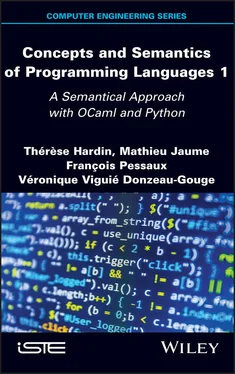
The domain of a memory dom(Mem) depends on the current environment and represents the space of references, which are accessible (directly or indirectly) from bound and non-masked identifiers in the current execution environment. The addition of a binding ( x , r ) to an environment Env has a twofold effect, creating ( x , r ) ⊕ Env and extending Mem to Mem[ r := v ].
NOTE.– Depending on the language or program in question, the value v may be supplied just when x is introduced, or later, or never. If no value is provided prior to its first use, the result of the program is unpredictable, leading to errors called initialization errors. Indeed, a location always contains a value, which does not need to be suited to the current computation if it has not been explicitly determined by the program.
Note that the addition of a binding ( x , r ) in an environment Env, of which the domain contains x , may mask a previous binding of x in Env, but will not add a new pair ( r , v ) to Mem if r was already present in the domain of Mem. Thus, any list of pairs representing a memory cannot contain two different pairs for the same reference. The memory Mem[ r := v ] verifies the following property:

The memory (Mem[ r1 := v1 ])[ r 2:= v2] is denoted as Mem[ r1 := v1 ][ r1 := v 2].
For example, (Mem[ r1 := v1 ][ r 2:= v 2])( r ) = v 2.
The function valeur_refcomputes the value stored at a given location. If nothing has previously been written at this location, the function returns a special value (None), indicating the absence of a known value (i.e. a value resulting from initialization or computation).
Python def valeur_ref(mem,a): if len(mem) == 0: return None else: a1,v1 = mem[0] if a == al: return v1 else: return valeur_ref(mem[1:],a)OCaml let rec valeur_ref mem a = match mem with | [] -> None | (a1, v1) :: t -> if a = a1 then Some v1 els (valeur_ref t a) val valeur_ref : (’a * ’b) list -> ’a -> ’b option
The following function writes a value into the memory:
Python def write_mem(mem,a,v): if len(mem) == 0: return [(a,v)] else: a1,v1 = mem[0] if a == a1: return [(a1,v)] + mem[1:] else: return [(a1,v1)] + write_mem(mem[1:],a,v)OCaml let rec write_mem mem a v = match mem with | [] -> [(a, v)] | (a1, v1) :: t -> if a = a1 then (a1, v) :: t else (a1, v1) :: (write_mem t a v) val write_mem : (’a * ’b) list -> ’a -> ’b -> (’a * ’b) list
A state is defined as a pair (Env , Mem) ∈ E× Msuch that any reference in the domain of Mem is accessible from a binding in Env. A reference is said to be accessible if its value can be read or written from an identifier contained in Env by a series of operations of reading, writing, or reference manipulation.
Given an environment Env, the set of identifiers Xis partitioned into two subsets:  which contains the identifiers bound to a reference, and
which contains the identifiers bound to a reference, and  , which contains the others:
, which contains the others:

The value associated with an identifier x in  is a reference Env( x ) = r where a value Mem( r ) is stored, which can be modified by writing. Identifiers of
is a reference Env( x ) = r where a value Mem( r ) is stored, which can be modified by writing. Identifiers of  are generally called mutable variables .
are generally called mutable variables .
2.2. Evaluation of expressions
The value of an expression is computed according to an evaluation environment and a memory, i.e. in a given state. This computation is defined by the evaluation semantics of the expression.
The language of expressions Exp 1used here will be extended in Chapters 3and 4. Its syntax is defined in Table 2.1.
Table 2.1. Language of expressions Exp 1
| e ::= k |
Integer constant |
( k ∈ ℤ) |
| | x |
Identifier |
( x ∈ X) |
| | e 1+ e 2 |
Addition |
( e 1, e 2∈ Exp 1) |
| | ! x |
Dereferencing |
( x ∈ X) |
Thus, an expression e ∈ Exp 1is either an integer constant k ∈ℤ, an identifier x ∈ X, an expression obtained by applying an addition operator to two expressions in Exp 1or an expression of the form ! x denoting the value stored in the memory at the location bound to the mutable variable x . Thus, this is an inductive definition of the set Exp 1. Note that Exp 1does not include an assignment construct. This is a deliberate choice. This point will be discussed in greater detail in section 2.3by means of an extension of Exp 1.
NOTE. – The symbol + used in defining the syntax of expressions does not denote the integer addition operator. It could be replaced by any other symbol (for example ⊠). Its meaning will be assigned by the evaluation semantics. The same is true of the constant symbols: for example, the symbol 4 may be interpreted as a natural integer, a relative integer or a character.
EXAMPLE 2.1.– ! x + y is an expression of Exp 1in the same way as ( x + 2) + 3. Parentheses are used here to structure the expression, they are part of the so-called concrete syntax and will disappear in the AST.
The set Exp 1of well-formed expressions of the language is defined by induction and expressed directly by a recursive sum type. Types of this kind can be constructed in OCaml, but not in Python; in the latter case, they can be partially simulated by defining a class for each sum-type constructor. Each class must contain a method with arguments corresponding exactly to the arguments of the sum type constructors it implements. An implementation of this type in Python is naive, and users must ensure that these classes are used correctly. We know that there are possibilities of programming dynamic type verification mechanisms in Python, which simulate strongtyping (similar to that used in OCaml) and ensure that the code is used correctly; however, these techniques lie outside of the scope of this book. The objective of all implementations shown in this book is simply to illustrate and intuitively justify the correct handling of concepts. As we have already done, we choose this approach to implement sum types.
Читать дальше



 which contains the identifiers bound to a reference, and
which contains the identifiers bound to a reference, and  , which contains the others:
, which contains the others:
 is a reference Env( x ) = r where a value Mem( r ) is stored, which can be modified by writing. Identifiers of
is a reference Env( x ) = r where a value Mem( r ) is stored, which can be modified by writing. Identifiers of  are generally called mutable variables .
are generally called mutable variables .










